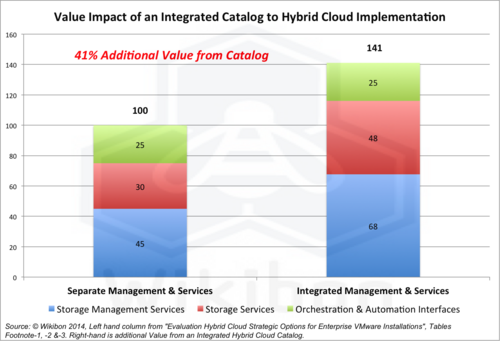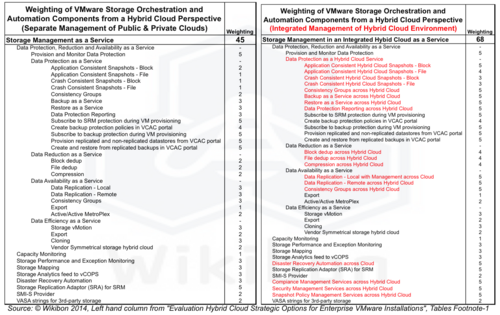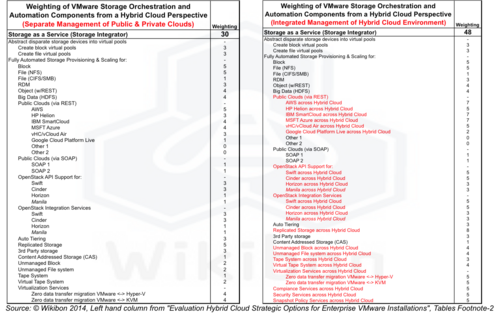The value of hybrid clouds is that it provides alternative services and locations where IT can be consumed by in-house users, customers, partners and other stakeholders. One of the strategic imperatives for enterprise IT is to be competitive with external providers for the services where application deployment provides significant value. Wikibon is focusing on cloud in general and hybrid cloud in particular and has recently publish research on hybrid cloud, entitled "Evaluation Hybrid Cloud Strategic Options for Enterprise VMware Installations".
This research builds on that publication to look at some of the management and service complexities that stem from hybrid cloud deployment. The basic challenge is to avoid deploying multiple administration and compliance teams for each individual cloud and creating the very silos that hybrid cloud is trying to obviate. The key conclusion of this research is the necessity for a comprehensive catalog of data and snapshots integrated into all components of a hybrid cloud. The catalog should track when data has been updated, mounted and deleted, when snapshots and snapshots of snapshots have been created, which applications have been deployed against what data when, etc. Wikibon believes that without an integrated catalog across the hybrid cloud, there will be significant overhead, increased costs and significant systemic risk to data and application integrity.
Hybrid Clouds Increase the Complexity of Data and Snapshot Management
Snapshots, in particular space efficient snapshots, have rapidly become the de facto way of creating copies of data and managing replication. Snapshotting is an essential tool for all-flash storage. For replication using snapshots, deltas of data that has changed can be migrated quickly between locations, enabling rapid recovery locally in the case of local disaster at another site. One of the challenges of snapshots is the lack of good management tools to keep track of the creation, use, protection and deletion of these logical copies of data. Hybrid clouds will amplify any data management weaknesses. Without robust integrated Hybrid-enabled snapshot and data management services, users have no effective automated way of deploying snapshots between the hybrid cloud elements.
With the increasing importance and ubiquity of all-flash arrays in the data center and the rapid migration to electronic data centers, the relative speed-to-access data at remote locations declines, and snapshot technologies become even more important. Integrated catalogs allow much greater and safer use and protection of snapshots in a hybrid cloud environment:
- Snapshot catalogs can improve recovery time and recovery effectiveness for applications supported by a hybrid cloud.
- Snapshot catalogs are vital for achieving the fastest Accurate Recovery of Applications across the Hybrid Cloud.
- Catalogs inform users of all the snapshots available, allowing them to select the closest or most recent or most appropriate snapshot from all the locations and services within the span of the hybrid cloud.
- Without an integrated snapshot management catalog service, communication costs between locations & services can skyrocket:
- Moving data between different locations within a hybrid cloud, especially over long distances, is expensive, difficult to manage and takes a very long time to complete;
- Understanding where the correct snapshots exists can minimize communication and operational costs and prevent snapshot duplication.
- Catalogs can reduce complexity and operational costs for backup and management in a hybrid environment:
- Snapshot and data catalogs can reduce backup and management costs in a hybrid cloud environment;
- Catalogs can contribute to reduction in data movement costs within a hybrid cloud (mutual backup);
- The can reduce hardware and software backup and management acquisition costs across the cloud.
- Snapshot catalogs can improve access to data for developers, QA and testing in a hybrid cloud:
- Development will often be in the cloud, and production in-house, and will use an integrated catalog to automate the identification and publication of development data copies
- Snapshots taking from nearest source avoid migration time and cost;
- Important to establish correct snapshot version is published and used appropriately for Testing & QA compliance;
Knowledge of Snapshot Provenance & Access History is Essential to Compliance & Risk Mitigation in a Hybrid Cloud Environment. Full compliance is not possible in a Hybrid Cloud environment without knowledge of all snapshots taken, where snapshots are deployed against which applications, and who has accessed those snapshots.
Estimating the Additional Value from Hybrid Catalogs
In earlier Wikibon research on hybrid clouds, Wikibon looked in detail at the value of VMware-based hybrid cloud functionality that currently exists. Wikibon evaluated the contribution to value of a list of functionality for Storage-Management-as-a-Service. The functions listed and the relative values are shown in in the left hand column of Table 1 in the Footnotes below. The total contribution of storage management as a service to the overall orchestration and automation potential for Hybrid cloud deployment was assessed as 45 points out of a total of 100 points.
Wikibon assessed the additional value that a hybrid cloud catalog would bring to the functions contributing to Storage-Management-as-a-Service. The functions in red in the right hand column in Table 1 have additional functionality as a result of the existence of a hybrid cloud catalog. In addition to the existing functionality, Wikibon assessed that three additional elements would also add significant value. These elements are the last the elements in red in the right hand column of Table 1 (Compliance management services across hybrid cloud, security management services across a hybrid cloud, and snapshot policy management across hybrid cloud.) Wikibon assed that the total value contribution would rise from 45 to 68, a value increase of an approximately 50%.
Wikibon also evaluated the contribution to value of a list of functionality for Storage-as-a-Service. The functions listed and the relative values are shown in in the left hand column of Table 2 in the Footnotes below. The total contribution of storage as a service to the overall orchestration and automation potential for Hybrid cloud deployment was assessed as 30 points out of a total of 100 points.
Wikibon assessed the additional value that a hybrid cloud catalog would bring to the functions contributing to storage as a service. The functions in red in the right hand column in Table 2 have additional functionality as a result of the existence of a hybrid cloud catalog. In addition to the existing functionality, Wikibon assessed that three additional elements would also add significant value. These elements are the last the elements in red in the right hand column of Table 2 (Compliance storage services across hybrid cloud, security services across hybrid cloud, and snapshot policy services across a hybrid cloud.) Wikibon assessed that the total value contribution would rise from 30 points to 48, a value increase of an approximately 60%.
The original research included a third category of value to a hybrid cloud environment, the orchestration and automation interfaces provided. This was assessed at 25 points out of 100. Wikibon assessed that a hybrid catalog would not provide any value to the interfaces over and above the value generated by contributing to storage services and storage management services. The left hand column in Figure 1 shows the summary of the potential value created by the hybrid cloud functionality was 100 points. The right hand column shows the original value plus the additional value created by a full hybrid cloud catalog. Wikibon assesses that additional value as 41%, as shown in the right hand column in Figure 1.

Source: © Wikibon 2014. The left hand column is from Wikibon Research "Evaluation Hybrid Cloud Strategic Options for Enterprise VMware Installations", Table Footnote-1, Table Footnote-2 & Table Footnote-3. The right-hand column evaluates the additional value from an integrated hybrid cloud catalog. The detailed calculations are in Table1 and Table 2 below
Action Item: CIOs and senior storage executives responsible for implementing hybrid clouds should ensure a full-functional hybrid cloud catalog is implemented as a key integrated component of the hybrid cloud deployment.
Footnotes:
Source: © Wikibon 2014. The left hand column is from Wikibon Research "Evaluation Hybrid Cloud Strategic Options for Enterprise VMware Installations", Table Footnote-1. The right-hand column evaluates the additional value for each function attributed to an integrated catalog for storage management services a hybrid cloud. The results are shown as the blue section of the columns in Figure 1 above.

Source: © Wikibon 2014. The left hand column is from Wikibon Research "Evaluation Hybrid Cloud Strategic Options for Enterprise VMware Installations", Table Footnote-2. The right-hand column evaluates the additional value for each function attributed to an integrated catalog for storage services a hybrid cloud. The results are shown as the red section of the columns in Figure 1 above.
Action Item:
Footnotes:


